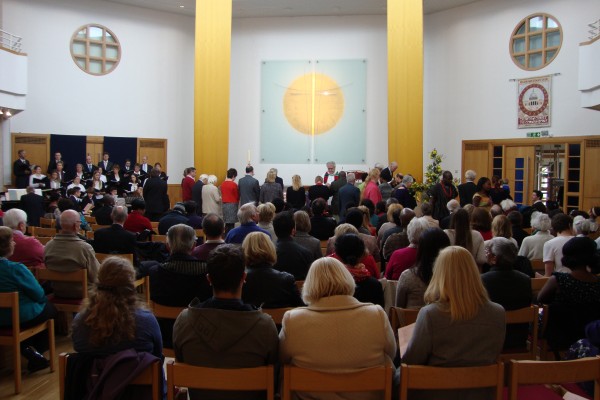Music to End the Day Sunday, 18 April 2021
Hello, everyone.
You may remember the inspiring Amazing Grace Pilgrimage back in September 2019, when people walked from Christ the Cornerstone to Olney, ‘home’ of Amazing Grace. The walk concluded with a lovely service in the Church of SS Peter and Paul, Olney, in which our musicians took part. In our morning service today we heard Stanford’s ‘O, for a closer walk with God’, recorded at that service. Now we hear Telemann’s Recorder Sonata in F, played on that same occasion by Rocio Sanchez.
Vivace & Adagio (movements 2 & 3) from Sonata in F [Telemann]
The Third Sunday of Easter invites us to focus on a much earlier walk – from Jerusalem to Emmaus, more or less the same distance as from Cornerstone to Olney. Two of Jesus’ disciples are joined by a stranger and they discuss with him the sadness of recent events in Jerusalem. Only when they persuade him to come and eat with them and he breaks bread do they recognise the stranger as the risen Jesus! It’s a wonderful story that invites us to reflect on the ways in which we encounter Jesus in our own lives (Luke 24: 13–35).
The American Lutheran Marty Haugen tells the Emmaus story in this lovely song, based on an Irish melody. Haugen reminds us that those ‘who welcome the stranger shall welcome the Lord’
On the journey to Emmaus with our hearts cold as stone-
the One who would save us had left us alone.
Then a stranger walks with us and, to our surprise,
he opens our stories and he opens our eyes.
And our hearts burned within us as we talked on the way,
how all that was promised was ours on that day.
So we begged him, ‘Stay with us and grant us your word.’
We welcomed the stranger and we welcomed the Lord.
And that evening at the table as he blessed and broke bread,
we saw it was Jesus arisen from the dead;
Though he vanished before us we knew he was near –
the life in our dying and the hope in our fear.
On the journey to Emmaus, in our stories and feast,
with Jesus we claim that the greatest is least:
and his words burn within us – let none be ignored –
who welcomes the stranger shall welcome the Lord.
Hymn: On the journey to Emmaus
We conclude with a beautiful contemporary setting of ‘Ubi Caritas’ by Norwegian composer Ola Gjeilo, one of his earliest choral works, written in 1999. Like the more famous setting by Maurice Duruflé, which inspired Gjeilo, the work is influenced by Gregorian chant.
Ubi caritas et amor, Deus ibi est.
Congregavit nos in unum Christi amor.
Exsultemus, et in ipso jucundemur.
Timeamus, et amemus Deum vivum.
Et ex corde diligamus nos sincero.
Ubi caritas et amor, Deus ibi est.
Simul ergo cum in unum congregamur:
Ne nos mente dividamur, caveamus.
Cessent iurgia maligna, cessent lites.
Et in medio nostri sit Christus Deus.
Ubi caritas et amor, Deus ibi est.
Simul quoque cum beatis videamus,
Glorianter vultum tuum, Christe Deus:
Gaudium quod est immensum, atque probum,
Saecula per infinita saeculorum.
Amen
Where charity and love are, God is there.
Love of Christ has gathered us into one.
Let us rejoice in Him and be glad.
Let us fear, and let us love the living God.
And from a sincere heart let us love one.
Where charity and love are, God is there.
At the same time, therefore, are gathered into one:
Lest we be divided in mind, let us beware.
Let evil impulses stop, let controversy cease.
And in the midst of us be Christ our God.
Where charity and love are, God is there.
At the same time we see that with the saints also,
Thy face in glory, O Christ our God:
The joy that is immense and good, Unto the
World without end.
Amen
Ubi Caritas [Gjeilo]
Adrian Boynton


